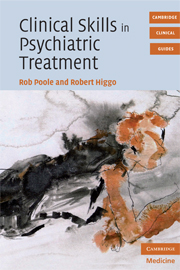Book contents
- Frontmatter
- Contents
- Acknowledgments
- Author biographies
- Introduction
- PART I UNDERLYING PRINCIPLES
- PART II THE CONTEXT AND LOCATION OF TREATMENT
- 5 Teams
- 6 Teamwork
- 7 Inpatient treatment in the era of community psychiatry
- 8 Compulsion and locked doors
- 9 Not at home, not in hospital
- 10 Models of care
- PART III PROBLEMS IN TREATMENT
- PART IV COPING
- Afterword: Optimism of the will and pessimism of the intellect
- References
- Index
9 - Not at home, not in hospital
from PART II - THE CONTEXT AND LOCATION OF TREATMENT
Published online by Cambridge University Press: 08 August 2009
- Frontmatter
- Contents
- Acknowledgments
- Author biographies
- Introduction
- PART I UNDERLYING PRINCIPLES
- PART II THE CONTEXT AND LOCATION OF TREATMENT
- 5 Teams
- 6 Teamwork
- 7 Inpatient treatment in the era of community psychiatry
- 8 Compulsion and locked doors
- 9 Not at home, not in hospital
- 10 Models of care
- PART III PROBLEMS IN TREATMENT
- PART IV COPING
- Afterword: Optimism of the will and pessimism of the intellect
- References
- Index
Summary
Even enthusiastic community psychiatrists have to acknowledge that some people with mental health problems cannot and should not be treated either in their own home or in hospital. The predominant international model of psychiatric practice is office-based one-to-one treatment. There is a large literature concerning this therapeutic environment. We would not suggest that there is anything intrinsically wrong with practising in this way. However, there are some problems associated with the main ‘not at home, not in hospital’ treatment options as they have developed in the UK. Traditional practices require modification if they are to continue to play a functional role in newer models of service provision, and some modalities of treatment may have to be abandoned all together.
The main problems associated with UK patterns of mental health practice have arisen because service development has tended to occur on an ad hoc basis. New approaches have been grafted onto traditional ways of working. In all fields of human endeavour, the familiar tends to be comfortable, which is why traditional ways of doing things sometimes persist long after they have become outmoded and dysfunctional. In Britain, as in many other countries, modern psychiatry developed out of the treatment of severely ill people in large mental hospitals. After the Second World War, psychiatrists started to practise beyond the asylum walls. As they did so, they extended the range of conditions that they attempted to treat.
- Type
- Chapter
- Information
- Clinical Skills in Psychiatric Treatment , pp. 88 - 96Publisher: Cambridge University PressPrint publication year: 2008



